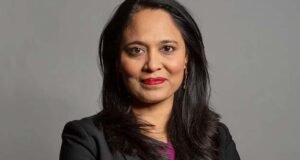 The UK’s foremost master planner, architect Sir Terry Farrell, says we should build low-cost rising bridges east of Tower Bridge to ease traffic and create new floating neighbourhoods for London’s exploding population.
The UK’s foremost master planner, architect Sir Terry Farrell, says we should build low-cost rising bridges east of Tower Bridge to ease traffic and create new floating neighbourhoods for London’s exploding population.
There are 34 bridges across the Thames in Greater London. Just one lies east of Tower Bridge, 20 miles downriver in Dartford — the Queen Elizabeth II Bridge, where roaring traffic snakes over the hump-backed monster day and night. Proposals to build scaled-down versions between Tower Bridge and Dartford to help ease traffic have been floated since the Seventies.
However, the UK’s foremost master planner, architect Sir Terry Farrell, has a better idea — build modern equivalents, not of the Dartford crossing, but of Tower Bridge.

“Only high-level bridges or tunnels are currently being planned. Low-level bridges, which lift a few times a day to let tall ships through, are a better alternative,” he says.
“They would act as catalysts for mixed-use development on either side of the river, turbo-charging existing plans for areas such as the Royal Docks and Thamesmead.”
Sir Terry has long been part of a chorus pushing for new foot and cycle Thames crossings mixed with more substantial new bridges for traffic. Just before Christmas, Mayor Boris Johnson called for 13 new crossings.
Sir Terry’s big idea is to build seven all-traffic crossings at ground level — centre-lift bridges whose prime purpose is to aid development on both sides of the river in currently marooned spots.
A low-level crossing enhances land values at both ends by 10 per cent, says BuroHappold. They are relatively cheap. You can get three to four low-level crossings for £100 million to £150 million a time for the price of one high-level bridge, according to consulting engineers BuroHappold. Sir Terry’s architecture practice Farrells concedes that one high-level crossing is needed. But that should be it.
Savills research director Susan Emmett agrees. “There is huge potential to create new neighbourhoods east of the city if we make best use of our land.”
BuroHappold has quantified the footfall benefits. “If 7,000 commuters pass the bridge each day, they’ll spend an estimated £7 million a year in shops, bakeries, food stores and pubs within the bridge’s area of influence.”
, from Fulham in the west to Dartford in the east. The majority of these will be built in east London, where current cross-river connections are poor and population growth is highest. The tunnels and bridges are part of a master plan for a new “City in the East”, stretching from London Bridge to Ebbsfleet, being pushed by the Mayor.
They include a pedestrian and cycle link between Canary Wharf and Rotherhithe, a crossing between Royal Docks and Charlton Riverside, and a new road bridge between Beckton and Thamesmead.
TfL is also mulling over two tolled crossing points and consultations on the £3 billion project close next month. A tunnel or a high-level bridge from Belvedere in Kent to Rainham in Essex is one route, while the other is a bridge at Gallions Reach, between Beckton and Thamesmead. Here, a crossing would span more than a mile, with ramps making up two thirds of the length. Sir Terry concedes one of these is needed to ease congestion.
But the price of dead ground is heavy. Farrells calculates that 55 acres of land underneath and around Gallions Reach inclines will be rendered unusable for housing and shops, while an area the size of Holland Park is “neutralised” — obliterating space for 2,600 homes. So why can’t we have a low-level bridge here? Why not plenty more?
Farrells has pinpointed seven spots on three stretches of the river. Two crossings would link the neck of the Isle of Dogs to the south bank — the first to Surrey Quays, the second to Greenwich. Downstream, one bridge replaces the Woolwich Ferry, while another links Charlton to Silvertown. Further east, there are two crossings from Thamesmead to Barking. All seven have rising centre sections like Tower Bridge, plus a fanciful moored flotilla of floating homes. There is potential for 47,000 homes within a mile and a quarter of the Thamesmead/Barking bridge, adds Farrells.
Pressure for new crossings is rising as fast as London’s population is hurtling towards 10 million. Last month, the Mayor unveiled TfL’s plans to build 13 new crossings by 2050. He said: “Building a series of new bridges is essential for the future prosperity of our rapidly growing city.” These TfL crossings are shaped by a parochial priority to move pedestrians and ease traffic.
The Port of London Authority’s 20-year Thames Vision, published last month, takes a similarly narrow view. The PLA’s priority is to encourage more ships, preferably under bridges high enough not to dent funnels. But Sir Terry is beginning to have an impact. His ideas came too late to influence the TfL and PLA reports, but the PLA acknowledges his impact on the debate.
“We have started a dialogue with Terry Farrell’s team to explore proposals for low-level bridges,” says James Trimmer, PLA director of planning. “However, it is fundamental that passage for river traffic can be maintained.” The PLA is reluctant to say how many times low-level bridges would have to be raised to allow ships to pass. “It would depend on the bridge heights, but it’s something we will discuss with TfL,” adds Trimmer.
 Weekly Bangla Mirror | Bangla Mirror, Bangladeshi news in UK, bangla mirror news
Weekly Bangla Mirror | Bangla Mirror, Bangladeshi news in UK, bangla mirror news







